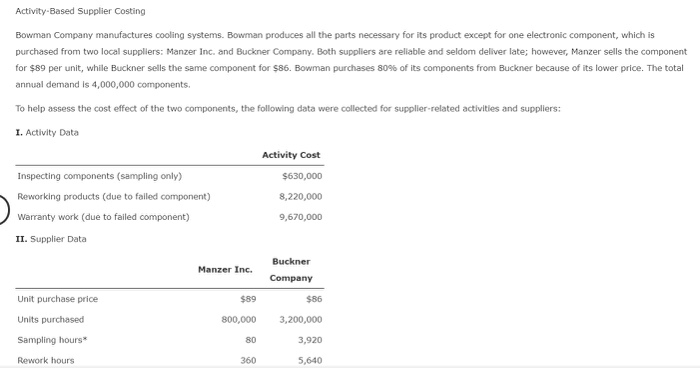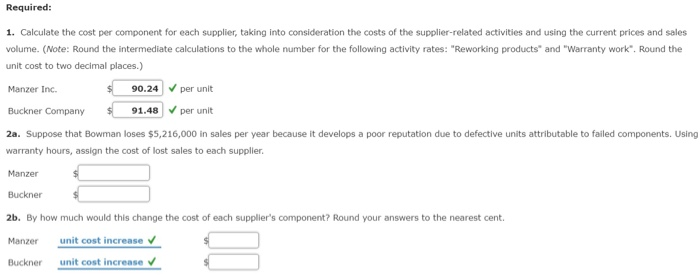Activity-Based Supplier Costing Bowman Company manufactures cooling systems. Bowman produces all the parts necessary for its product except for one electronic component, which is purchased from two local suppliers: Manzer Inc, and Buckner Company. Both suppliers are reliable and seldom deliver late; however, Manzer sells the component for $89 per unit, while Buckner sells the same component for $86. Bowman purchases 80% of its components from Buckner because of its lower price. The total annual demand is 4,000,000 components To help assess the cost effect of the two components, the following data were collected for supplier-related activities and suppliers: I. Activity Data Activity Cost $630,000 8,220,000 9,670,000 Inspecting components (sampling only) Reworking products (due to failed component) Warranty work (due to failed component) II. Supplier Data Buckner Manzer Inc. Company Unit purchase price Units purchased Sampling hours* Rework hours $86 00,0003,200,000 3,920 5,640 $89 80 360 Required 1. Calculate the cost per component for each supplier, taking into consideration the costs of the supplier-related activities and using the current prices and sales volume. (Note: Round the intermediate calculations to the whole number for the following activity rates: "Reworking products" and "Warranty work. Round the unit cost to two decimal places.) Manzer Inc. Buckner Company 2a. Suppose that Bowman loses $5,216,000 in sales per year because it develops a poor reputation due to defective units attributable to failed components. Using warranty hours, assign the cost of lost sales to each supplier. 90.24 per unit 91.48 per unit Manzer Buckner 2b. By how much would this change the cost of each supplier's component? Round your answers to the nearest cent. Manzer unit cost increase Buckner unit cost increase Activity-Based Supplier Costing Bowman Company manufactures cooling systems. Bowman produces all the parts necessary for its product except for one electronic component, which is purchased from two local suppliers: Manzer Inc, and Buckner Company. Both suppliers are reliable and seldom deliver late; however, Manzer sells the component for $89 per unit, while Buckner sells the same component for $86. Bowman purchases 80% of its components from Buckner because of its lower price. The total annual demand is 4,000,000 components To help assess the cost effect of the two components, the following data were collected for supplier-related activities and suppliers: I. Activity Data Activity Cost $630,000 8,220,000 9,670,000 Inspecting components (sampling only) Reworking products (due to failed component) Warranty work (due to failed component) II. Supplier Data Buckner Manzer Inc. Company Unit purchase price Units purchased Sampling hours* Rework hours $86 00,0003,200,000 3,920 5,640 $89 80 360 Required 1. Calculate the cost per component for each supplier, taking into consideration the costs of the supplier-related activities and using the current prices and sales volume. (Note: Round the intermediate calculations to the whole number for the following activity rates: "Reworking products" and "Warranty work. Round the unit cost to two decimal places.) Manzer Inc. Buckner Company 2a. Suppose that Bowman loses $5,216,000 in sales per year because it develops a poor reputation due to defective units attributable to failed components. Using warranty hours, assign the cost of lost sales to each supplier. 90.24 per unit 91.48 per unit Manzer Buckner 2b. By how much would this change the cost of each supplier's component? Round your answers to the nearest cent. Manzer unit cost increase Buckner unit cost increase








